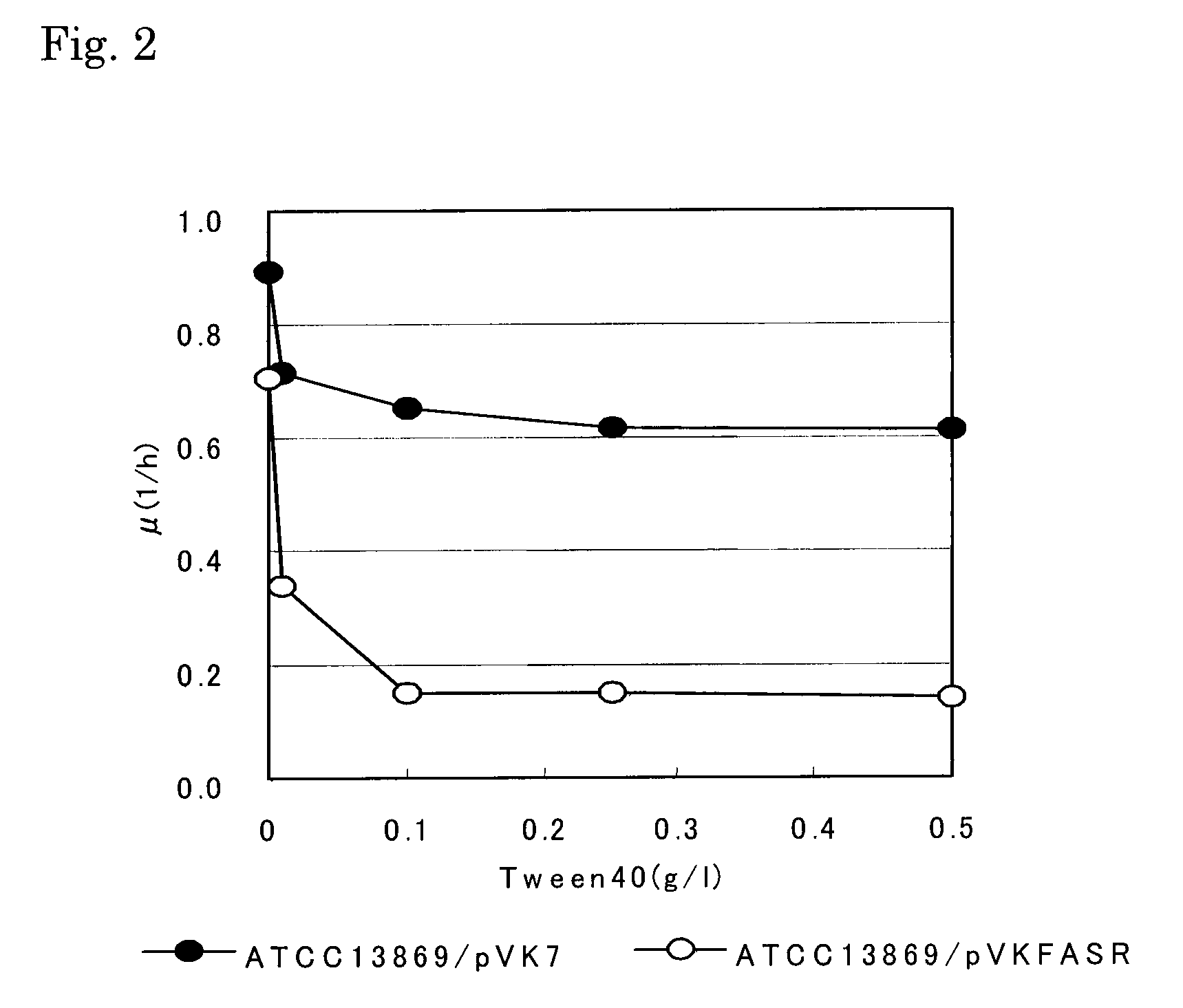L-Glutamic Acid Producing Bacterium and a Method for Production of L-Glutamic Acid
a technology of l-glutamic acid and producing bacteria, which is applied in the field of fermentation industry, can solve the problems of increasing the cost of production, increasing the amount of biotin, and many inexpensive raw materials used as carbon sources in culturing contain an excessive amount of biotin, so as to improve the ability of coryneform bacteria to produce l-glutamic acid, the effect of improving the ability of the bacteria
- Summary
- Abstract
- Description
- Claims
- Application Information
AI Technical Summary
Benefits of technology
Problems solved by technology
Method used
Image
Examples
example 1
Preparation of a fasR-Amplified Strain of C. glutamicum ATCC13869
[0128]A plasmid for amplifying the fasR gene was prepared. Since the total genome sequence of C. glutamicum has been reported, a chromosome was extracted from C. glutamicum ATCC13869 by using Bacterial Genomic DNA Purif. Kit (MS Techno Systems), and PCR was performed using this chromosome as a template and a combination of the primers of SEQ ID NOS: 1 and 2 to amplify a fragment of about 900 bp. PCR was performed by using Pyrobest polymerase (Takara Bio Inc.) with a cycle of denaturation at 98° C. for 10 seconds, annealing at 55° C. for 30 seconds, and extension at 72° C. for 2 minutes, which was repeated 25 times. The KpnI sequence was added to the primers of SEQ ID NOS: 1 and 2 at the 5′-end, and the region of 111 to 1010 of SEQ ID NO: 3 was amplified.
[0129]The amplified fragment was completely digested with KpnI, and ligated to the pVK7 vector (described in Japanese Patent Laid-open No. 10-215883) which had been sim...
example 2
Confirmation of Glutamic Acid Producing Ability of ATCC 13869 / pVKFASR Strain
[0131]The ability of the ATCC13869 / pVKFASR strain to produce glutamic acid was examined by performing the culture using a Sakaguchi flask. A control strain, ATCC13869 / pVK7, which was obtained by introducing the vector into the wild-type strain, and the fasR-amplified ATCC13869 / pVKFASR strain were cultured at 31.5° C. in the CM-2B agar medium (10 μl of polypeptone, 5 μl of yeast extract, 5 μl of NaCl, 10 μg / l of biotin, 20 μl of agar, adjusted to pH 7.0 with KOH) containing 25 μg / ml of kanamycin for one whole day, and inoculated into 20 ml of a seed culture medium (80 μl of glucose, 30 μl of ammonium sulfate, 1 μl of KH2PO4, 0.4 g / l of MgSO4.7H2O, 0.01 μl of FeSO4.7H2O, 0.01 μl of MnSO4.4-5H2O, 200 μg / l of vitamin B1, 0.48 μl of soy bean protein hydrolysate, 300 μl of biotin, adjusted to pH 8.0 with KOH). One g of calcium carbonate which had been previously subjected to dry heat sterilization was added to the...
example 3
Change of Sensitivity of ATCC13869 / pVKFASR Strain to Surfactant
[0133]Since glutamic acid production was induced in the fasR-amplified strain only at low concentrations of surfactant, it appears that the sensitivity of the strain to the surfactant increased as compared with the control strain (vector-introduced strain ATCC13869 / pVK7). Therefore, the sensitivity of the fasR-amplified strain to a surfactant was examined. Cells grown at 31.5° C. on the CM-2B agar medium over one whole day were inoculated to the CM-2B liquid medium, and Tween 40 was added to the medium at a concentration of 0.01, 0.1, 0.25 or 0.5 μl, or was not added. By performing a test tube culture, absorption at 620 nm (OD 620 nm) was measured over time. The specific growth rate was calculated, and the results are shown in FIG. 2. A marked decrease in the specific growth rate was observed for the fasR-amplified strain when 0.01 g / L of the surfactant was added, and thus it was confirmed that the fasR gene was able to ...
PUM
| Property | Measurement | Unit |
|---|---|---|
| Sensitivity | aaaaa | aaaaa |
Abstract
Description
Claims
Application Information
 Login to View More
Login to View More - R&D
- Intellectual Property
- Life Sciences
- Materials
- Tech Scout
- Unparalleled Data Quality
- Higher Quality Content
- 60% Fewer Hallucinations
Browse by: Latest US Patents, China's latest patents, Technical Efficacy Thesaurus, Application Domain, Technology Topic, Popular Technical Reports.
© 2025 PatSnap. All rights reserved.Legal|Privacy policy|Modern Slavery Act Transparency Statement|Sitemap|About US| Contact US: help@patsnap.com


